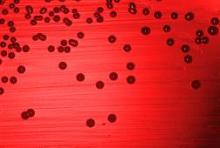WASHINGTON – For adults with Haemophilus influenzae-related community acquired pneumonia, fluoroquinolones were significantly associated with early clinical response rates that were better than those seen with other antibiotics, based on the findings of a German study.
“Initial treatment with any fluoroquinolone was the only positive predictor of early clinical response, and use of macrolide monotherapy was the only negative predictor of early clinical response,” Dr. Christina Forstner, a researcher at the Medical University of Vienna in Austria, said at the annual Interscience Conference on Antimicrobial Agents and Chemotherapy.
The multi-center, observational, prospective, cohort study was conducted between 2002 and 2012 in 171 adults who had community acquired pneumonia and tested positive for H.influenzae. In 124 patients, H.influenzae was the sole pathogen detected, whereas 47 patients had at least one other co-infection.
The primary end point of the study was an early clinical response ‑ clinical stability by day 4 of treatment. The secondary end point was clinical cure anywhere at day 14. The choice of antimicrobial treatment was left to the discretion of individual clinicians.
Early clinical response rates were seen for 46 of 47 patients (97.6%) given any fluoroquinolone, with 100% clinical cure by day 14. Fluoroquinolone monotherapy achieved a nearly 100% early clinical response rate (39 out of 40 patients), and complete clinical cure was seen in all patients by day 14. The rates were significantly different from those seen with other antibiotics (P = .01).
An early clinical response rate was seen in 92 of 108 patients (85.2%) given any beta-lactam. Beta-lactam monotherapy achieved an early clinical response rate in 63 out of 74 cases, with a clinical cure rate at day 14 in 68 out of 74 cases.
An early clinical response rate was seen in 29 of 36 patients (80.6%) who received any macrolide; an early clinical response rate was seen in 8 of 12 patients given monotherapy with a macrolide. Clinical cure rate at day 14 was 32 out of 36 patients given any macrolide, and 11 out of 12 given macrolide monotherapy.
The median duration of therapy was, according to Dr. Forstner, “quite long” at 10 days. Monotherapy was used in 78.4% of patients, and oral treatments in 63.7%.
The overall early clinical response rate was 88%, with an overall clinical cure of 93% on day 14, and of 95.9% on day 28.
A univariate analysis of age, body mass index, severity of disease, co-infection, and treatments used indicated the only factor associated with an early clinical response was the use of any fluoroquinolone (odds ration, 8.8). Macrolide monotherapy was associated with a negative clinical response (OR, 0.239).


